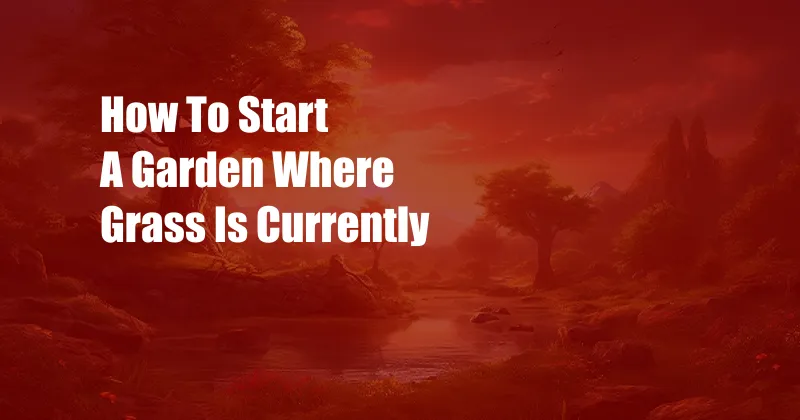
How to Transform Your Grassy Lawn into a Thriving Garden
I recall my excitement when I first envisioned transforming my mundane lawn into a vibrant garden. The prospect of nurturing my own plants and witnessing them bloom filled me with immense joy. However, turning a grassy area into a fertile garden requires careful planning and execution. In this blog post, I will share my journey of turning my grassy lawn into a flourishing garden, providing you with detailed guidance to embark on this horticultural adventure.
Starting a Garden: Understanding Your Soil
The Importance of Soil Preparation
The foundation of a thriving garden lies in its soil. Before embarking on your gardening journey, it is crucial to assess your soil’s composition and fertility. To conduct a basic soil test, gather a sample from your lawn and send it to a local extension office or a commercial soil testing lab. The results will provide insights into your soil’s pH, nutrient levels, and texture. Understanding these parameters will guide you in amending and preparing your soil effectively.
Soil amendments play a vital role in enhancing soil quality and fostering plant growth. Based on your soil test results, you may need to incorporate organic matter such as compost, manure, or peat moss to improve soil structure and fertility. Additionally, adjusting the soil pH using lime or sulfur may be necessary to create an optimal environment for your desired plants. Proper soil preparation ensures that your plants have access to the essential nutrients they need to thrive.
Planning Your Garden Layout
Once your soil is prepared, it is time to plan the layout of your garden. Consider the amount of space available, the types of plants you wish to grow, and the amount of sunlight your garden receives. Divide the area into smaller sections, taking into account companion planting principles to maximize space and enhance plant growth. For example, planting nitrogen-fixing plants like beans or peas near heavy feeders like tomatoes can provide natural fertilization.
When selecting plants, consider their size, hardiness, and water requirements. Place taller plants towards the back of the garden to avoid shading smaller ones. Group plants with similar water needs together to simplify watering practices. By carefully planning your garden’s layout, you can create a harmonious and thriving ecosystem for your plants.
Planting and Maintenance
With your garden layout in place, it is time to plant your seedlings or transplants. Dig holes twice the width of the root ball and deep enough to accommodate the entire root system. Gently loosen the roots before placing the plant in the hole and backfill with soil, firming it around the base to eliminate air pockets. Water thoroughly after planting.
Regular maintenance is essential to ensure the success of your garden. Watering, fertilizing, and weeding are crucial tasks to keep your plants healthy and productive. Water deeply and regularly, especially during hot, dry weather. Fertilize your plants according to their needs, using organic or synthetic fertilizers. Timely weeding prevents competition for water and nutrients, promoting the growth of your desired plants.
Pest and Disease Management
Protecting your garden from pests and diseases is paramount for maintaining its health and productivity. Regularly inspect your plants for signs of infestation or disease. Early detection and treatment can prevent significant damage. Practice crop rotation to disrupt the life cycles of pests and diseases. Encourage beneficial insects like ladybugs and lacewings to control pests naturally. If necessary, use organic or chemical pesticides or fungicides to combat infestations, always following label instructions carefully.
By implementing these pest and disease management strategies, you can safeguard your garden and ensure a bountiful harvest.
Harvesting and Enjoying the Fruits of Your Labor
As your plants mature, it is time to reap the rewards of your hard work. Harvest vegetables and fruits when they reach their optimal ripeness, using sharp tools to avoid damaging the plants. Store produce properly to extend its shelf life. Whether you enjoy the fruits of your labor fresh, preserve them for later use, or share them with friends and family, the satisfaction of harvesting your own produce is unparalleled.
Gardening is a rewarding endeavor that provides numerous benefits, from fresh, healthy produce to relaxation and stress relief. By understanding the principles outlined in this guide, you can transform your grassy lawn into a thriving garden, creating a beautiful and bountiful space to enjoy for seasons to come.
FAQs on Starting a Garden
Q: What is the best time to start a garden?
A: The ideal time to start a garden varies depending on your climate. As a general rule, it is best to start in the spring after the last frost date. However, some vegetables can be planted in the fall and overwintered for an early spring harvest.
Q: How do I choose the right plants for my garden?
A: Consider your climate, soil type, sunlight conditions, and personal preferences when selecting plants. Research different varieties to determine their specific needs and choose plants that are well-suited to your growing conditions.
Q: How often should I water my plants?
A: Watering frequency depends on several factors, including soil type, weather conditions, and plant type. As a general rule, water deeply and regularly, especially during hot, dry weather. Allow the soil to dry slightly between waterings to prevent overwatering.
Q: What is the best way to fertilize my plants?
A: Different plants have different fertilizer needs. Research the specific requirements of your plants and fertilize accordingly. Organic fertilizers, such as compost and manure, provide a slow release of nutrients. Synthetic fertilizers provide a quick boost of nutrients but should be used sparingly.
Q: How can I control pests and diseases in my garden?
A: Practice crop rotation, encourage beneficial insects, and regularly inspect your plants for signs of infestation or disease. Use organic or chemical pesticides or fungicides only when necessary, following label instructions carefully.
Would you like to learn more about starting a garden where grass is currently? Let me know in the comments below!